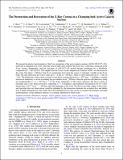| dc.contributor.author | Ricci, C | |
| dc.contributor.author | Kara, Erin A | |
| dc.contributor.author | Loewenstein, M | |
| dc.contributor.author | Trakhtenbrot, B | |
| dc.contributor.author | Arcavi, I | |
| dc.contributor.author | Remillard, Ronald Alan | |
| dc.contributor.author | Fabian, AC | |
| dc.contributor.author | Gendreau, KC | |
| dc.contributor.author | Arzoumanian, Z | |
| dc.contributor.author | Li, R | |
| dc.contributor.author | Ho, LC | |
| dc.contributor.author | MacLeod, CL | |
| dc.contributor.author | Cackett, E | |
| dc.contributor.author | Altamirano, D | |
| dc.contributor.author | Gandhi, P | |
| dc.contributor.author | Kosec, P | |
| dc.contributor.author | Pasham, Dheeraj Ranga Reddy | |
| dc.contributor.author | Steiner, James F | |
| dc.contributor.author | Chan, CH | |
| dc.date.accessioned | 2022-08-05T16:51:50Z | |
| dc.date.available | 2021-09-20T18:22:26Z | |
| dc.date.available | 2022-08-05T16:51:50Z | |
| dc.date.issued | 2020 | |
| dc.identifier.uri | https://hdl.handle.net/1721.1/132446.2 | |
| dc.description.abstract | © 2020. The American Astronomical Society. All rights reserved. We present the drastic transformation of the X-ray properties of the active galactic nucleus (AGN) 1ES 1927+654, following a changing-look event. After the optical/ultraviolet outburst the power-law component, produced in the X-ray corona, disappeared, and the spectrum of 1ES 1927+65 instead became dominated by a blackbody component (kT ∼ 80-120 eV). This implies that the X-ray corona, ubiquitously found in AGNs, was destroyed in the event. Our dense ∼450 days long X-ray monitoring shows that the source is extremely variable in the X-ray band. On long timescales the source varies up to ∼4 dex in ∼100 days, while on short timescales up to ∼2 dex in ∼8 hr. The luminosity of the source is found to first show a strong dip down to ∼1040 erg s-1 , and then a constant increase in luminosity to levels exceeding the pre-outburst level ⪆300 days after the optical event detection, rising up asymptotically to ∼2 × 1044 erg s-1. As the X-ray luminosity of the source increases, the X-ray corona is recreated, and a very steep power-law component (Γ ≃ 3) reappears, and dominates the emission for 0.3-2 keV luminosities ≳ 1043.7 erg s-1, ∼300 days after the beginning of the event. We discuss possible origins of this event, and speculate that our observations could be explained by the interaction between the accretion flow and debris from a tidally disrupted star. Our results show that changing-look events can be associated with dramatic and rapid transformations of the innermost regions of accreting supermassive black holes. | en_US |
| dc.language.iso | en | |
| dc.publisher | American Astronomical Society | en_US |
| dc.relation.isversionof | 10.3847/2041-8213/ab91a1 | en_US |
| dc.rights | Article is made available in accordance with the publisher's policy and may be subject to US copyright law. Please refer to the publisher's site for terms of use. | en_US |
| dc.source | The American Astronomical Society | en_US |
| dc.title | The Destruction and Recreation of the X-Ray Corona in a Changing-look Active Galactic Nucleus | en_US |
| dc.type | Article | en_US |
| dc.contributor.department | MIT Kavli Institute for Astrophysics and Space Research | en_US |
| dc.contributor.department | Massachusetts Institute of Technology. Department of Physics | en_US |
| dc.relation.journal | Astrophysical Journal Letters | en_US |
| dc.eprint.version | Final published version | en_US |
| dc.type.uri | http://purl.org/eprint/type/JournalArticle | en_US |
| eprint.status | http://purl.org/eprint/status/PeerReviewed | en_US |
| dc.date.updated | 2020-10-30T16:55:53Z | |
| dspace.orderedauthors | Ricci, C; Kara, E; Loewenstein, M; Trakhtenbrot, B; Arcavi, I; Remillard, R; Fabian, AC; Gendreau, KC; Arzoumanian, Z; Li, R; Ho, LC; MacLeod, CL; Cackett, E; Altamirano, D; Gandhi, P; Kosec, P; Pasham, D; Steiner, J; Chan, CH | en_US |
| dspace.date.submission | 2020-10-30T16:56:04Z | |
| mit.journal.volume | 898 | en_US |
| mit.journal.issue | 1 | en_US |
| mit.license | PUBLISHER_POLICY | |
| mit.metadata.status | Publication Information Needed | en_US |
